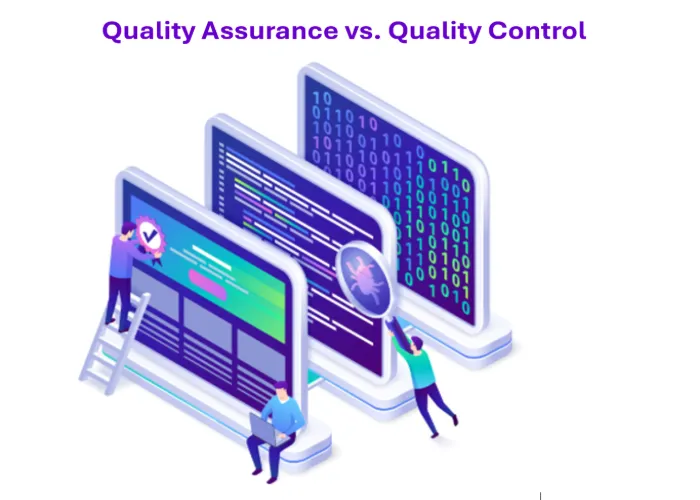Seven Principles of Testing: Know How To Best Apply Them

Introduction
Software testing is a vital component within the software development lifecycle. It ensures that the software product is free from defects and performs as expected. The principles of software testing provide a framework for designing effective test cases and strategies. This blog post will explore the seven principles of software testing, each accompanied by a practical example.
Why The Seven Principles of Software Testing Are Used
The seven principles of testing serve as foundational pillars upon which the entire testing process is built. They provide a comprehensive framework that guides testers in navigating the complexities of software development and quality assurance. By adhering to these principles, testers can effectively steer their efforts towards achieving the overarching goal of delivering high-quality software products that satisfy the needs and expectations of stakeholders.
These principles act as guiding lights, illuminating the path towards successful testing endeavors:
Understanding Purpose and Context:
Before embarking on testing activities, it’s crucial to understand the purpose and context of the software being developed. By comprehending the goals, requirements, and constraints of the project, testers can tailor their approach to testing to align with the specific needs of stakeholders.
Risk Management and Prioritization:
Testing is fundamentally a risk management activity. By identifying, assessing, and prioritizing risks associated with software quality, testers can allocate their resources and efforts effectively to focus on areas of highest importance and potential impact.
Early Detection and Prevention:
Detecting and addressing defects early in the development lifecycle is significantly more cost-effective than dealing with them later. By incorporating testing activities as early as possible in the software development process, testers can nip potential issues in the bud, preventing them from escalating into more significant problems down the line.
Iterative Improvement and Adaptation:
Testing is an iterative process that evolves over time. By continuously learning from past experiences, refining testing strategies, and adapting to changing circumstances, testers can enhance the effectiveness and efficiency of their testing efforts with each iteration.
Comprehensive Coverage within Constraints:
While it’s impossible to test every possible aspect of a complex software system exhaustively, testers must strive to achieve comprehensive coverage within the constraints of time, resources, and other limitations. By prioritizing testing activities based on factors such as criticality, probability of failure, and business impact, testers can maximize their chances of uncovering important defects.
Transparency and Communication:
Effective communication and transparency are essential for successful testing outcomes. Testers must collaborate closely with other stakeholders, including developers, project managers, and end-users, to ensure a shared understanding of testing objectives, findings, and implications.
Continuous Learning and Improvement:
Testing is not a static activity but rather a continuous journey of learning and improvement. Testers should actively seek opportunities to enhance their skills, explore new testing techniques and tools, and stay abreast of industry best practices and emerging trends to remain effective in their roles.
In essence, the seven principles of testing serve as a compass that guides testers through the intricate landscape of software quality assurance. By embracing these principles and integrating them into their testing practices, testers can navigate challenges, mitigate risks, and ultimately deliver software products of the highest quality that meet the diverse needs and expectations of stakeholders.
The Seven Principles of Software Testing
It’s crucial to strive for optimal test outcomes when conducting software testing, all while staying true to the overarching goal. However, how can you ensure that your testing strategy remains on the right track? The answer lies in adhering to fundamental testing principles. Here are the seven commonly practiced testing principles in the software industry:
Principle 1: Testing Shows the Presence of Defects
Principal Explained:
This principle serves as a fundamental reminder that testing is primarily about identifying defects rather than proving their absence. No matter how exhaustive the testing process, it cannot guarantee that a piece of software is entirely defect-free. Instead, testing provides evidence of the presence of defects within the system.
Example:
For instance, imagine a scenario where a team is testing an e-commerce website. They perform various tests on the checkout process, including entering invalid payment information. If the system correctly identifies and handles the invalid input by displaying an error message, it confirms the presence of a defect in the form of a validation issue.
However, if the system accepts the invalid payment information without any error, it still does not guarantee the absence of other defects. There might be security vulnerabilities, calculation errors, or usability issues lurking within the system that the current test cases did not uncover.
Overview:
This principle explains the importance of thorough and diverse testing techniques to uncover defects from different angles. It also highlights the need for a risk-based approach to prioritize testing efforts on critical functionalities and potential areas of weakness.
In summary, while testing can reveal the presence of defects, it cannot assure their absence. Testers must maintain a vigilant mindset and utilize a variety of testing methods to uncover defects effectively, thereby improving the overall quality and reliability of the software.
Principle 2: Exhaustive Testing is Impossible
Principal Explained:
This principle underscores the reality that it is impractical and often impossible to test every possible combination of inputs, outputs, and execution paths within a software program. The sheer complexity and variability of modern software systems make it infeasible to achieve complete coverage through testing alone. For instance, let’s look at a relatively straightforward function that accepts a 10-digit integer input. To test every possible value a 10-digit integer field can accept, well brace yourself, we’re talking billions of test cases required to cover all possible permutations exhaustively.
Instead of pursuing an unattainable goal of exhaustive testing, testers should rely on various strategies to prioritize their efforts and focus on areas most likely to contain defects. One such strategy is risk analysis, where testers assess the potential impact and likelihood of different types of defects occurring within the system. By identifying high-risk areas, such as critical functionalities or components with a history of issues, testers can allocate their resources more effectively.
Another approach is prioritization, where testers focus their testing efforts on areas that are most critical to the success of the software or pose the highest risk to its quality. This may involve targeting specific features, user scenarios, or components that are essential for the software’s functionality or have the potential to cause significant harm if they fail.
Example:
For example, consider a web-based banking application undergoing testing. Instead of attempting to test every possible combination of user actions, transaction types, and system states, testers may prioritize testing on critical functionalities such as login, account balance retrieval, fund transfers, and bill payments. They may also focus on scenarios involving large transactions or sensitive data to mitigate the risk of financial loss or security breaches.
Overview:
By embracing the principle that exhaustive testing is impossible, testers can adopt a more pragmatic and risk-based approach to testing. This allows them to maximize the effectiveness of their testing efforts within the constraints of time, resources, and project objectives, ultimately improving the overall quality and reliability of the software.
Principle 3: Early Testing
Principal Explained:
This principle emphasizes the importance of initiating testing activities as early as possible in the software development lifecycle. By incorporating testing from the outset, teams can identify and address issues proactively, ultimately saving time, effort, and resources in the long run.
Early testing encompasses various activities, including reviewing requirements, specifications, and design documents to ensure clarity, completeness, and feasibility. By scrutinizing these artifacts before any code is written, teams can identify potential ambiguities, contradictions, or missing requirements that could lead to costly rework or misunderstandings later on.
Example:
For example, consider a team developing a new mobile application for a social networking platform. Before a single line of code is written, testers can review the project’s requirements and wireframes to ensure that they accurately reflect the stakeholders’ needs and expectations. During this review process, testers may identify inconsistencies in user interface designs, conflicting functional requirements, or performance constraints that need clarification or refinement.
By addressing these issues early in the development process, the team can prevent misunderstandings and misalignments that could derail the project later on. Moreover, early testing can help set the stage for subsequent development activities by providing clear guidance and validation of project goals and objectives.
Overview:
Furthermore, early testing allows teams to establish a solid foundation for subsequent testing activities, such as unit testing, integration testing, and system testing. By validating requirements and designs upfront, testers can create more effective test cases and scenarios that accurately reflect the intended functionality and behavior of the software.
Overall, embracing the principle of early testing enables teams to detect and address issues sooner, reducing the likelihood of costly rework, schedule delays, and quality defects later in the development lifecycle. By investing in testing early on, organizations can build higher-quality software products that better meet the needs and expectations of their stakeholders.
Principle 4: Defect Clustering
Principal Explained:
This principle draws on the Pareto Principle, also known as the 80/20 rule, which suggests that roughly 80% of deffects come from 20% of causes. Applied to software testing, this means that a relatively small number of modules or components often contain the majority of defects discovered during testing. Identifying and prioritizing these defect-prone areas can significantly enhance the effectiveness of testing efforts.
Example:
For example, imagine a team is developing a new e-commerce platform. Through previous testing cycles or analysis of historical defect data, they discover that the checkout process consistently accounts for a significant portion of reported defects. This insight suggests that focusing testing efforts on the checkout functionality, such as payment processing, order validation, and shipping calculations, is likely to yield the greatest return in terms of defect detection and prevention.
By concentrating resources and attention on these high-risk areas, testers can uncover defects more efficiently and allocate testing efforts where they are most needed. This targeted approach allows teams to maximize the impact of their testing activities and prioritize remediation efforts to address critical issues promptly.
Overview:
Moreover, defect clustering can inform future development and testing strategies. By identifying patterns or commonalities among defect-prone modules, teams can implement proactive measures to prevent similar issues from arising in future projects. This might include enhancing code review processes, improving developer training on specific technologies or design patterns, or investing in automated testing tools tailored to the identified problem areas.
Overall, embracing the principle of defect clustering enables teams to work smarter, not harder, by focusing testing efforts on the areas of the system most likely to harbor defects. By leveraging insights from past testing experiences, teams can optimize their testing strategies, improve software quality, and deliver more reliable and robust products to users.
Principle 5: Pesticide Paradox
Principal Explained:
The pesticide paradox principle in software testing highlights the risk of relying solely on a fixed set of test cases. Just as pests can develop resistance to a particular pesticide over time, so too can software defects become immune to detection by repetitive testing. To mitigate this risk, testers must regularly review and update their test cases, introducing new and varied scenarios to uncover previously undetected defects.
Example:
For example, consider a team responsible for testing a mobile banking application. Initially, they develop a comprehensive suite of test cases covering various functionalities such as account login, balance inquiry, fund transfers, and bill payments. While these test cases may effectively detect defects during the initial testing phase, over time, the application evolves with new features, updates, and bug fixes.
If the testing team continues to rely solely on the original set of test cases without incorporating new scenarios or revisiting existing ones, they run the risk of overlooking emerging defects or regression issues introduced by recent changes. This is analogous to spraying the same pesticide repeatedly, eventually leading to the proliferation of resistant pests.
Overview:
To address the pesticide paradox, testers must adopt a proactive approach to test case maintenance and enhancement. This involves periodically reviewing existing test cases to identify areas for improvement, such as adding boundary cases, edge conditions, or corner cases that were not previously covered. Additionally, testers should stay informed about changes to the software under test, including new features, bug fixes, and user feedback, to ensure that test cases remain relevant and effective.
By continuously evolving and diversifying their test cases, testers can overcome the pesticide paradox and maintain the efficacy of their testing efforts over time. This iterative approach helps ensure that defects are consistently identified and addressed, ultimately improving the overall quality and reliability of the software.
Principle 6: Testing is Context-Dependent
Principal Explained:
The principle of context-dependence in software testing underscores the notion that testing strategies, techniques, and priorities must be tailored to the specific context in which the software product will be used. Different applications serve different purposes, cater to diverse user demographics, operate within varying regulatory environments, and possess unique quality attributes. Therefore, testing approaches should be adapted to address the particular requirements and challenges posed by each context.
Example:
For example, let’s contrast the testing requirements for two distinct software applications: a banking application and a weather forecasting app.
For the banking application, security and data integrity are paramount due to handling sensitive financial transactions and personal data. Testing would involve rigorous security checks to identify vulnerabilities like SQL injection and XSS. Additionally, extensive testing of transaction processing and encryption mechanisms is crucial. Compliance testing with regulatory standards such as PCI-DSS and GDPR is also necessary.
Conversely, the weather forecasting app focuses on validating data accuracy and reliability. While security is important, it does not handle sensitive information like the banking app. Testing would focus more on assessing performance under various network conditions, ensuring compatibility across devices, and prioritizing user experience with usability and accessibility testing.
In both examples, the testing approach is shaped by the specific context of the application and its intended use. While security and data integrity are paramount for the banking application, accuracy, performance, and user experience take precedence for the weather forecasting app.
Overivew:
By recognizing and embracing the principle of context-dependence in testing, teams can develop more targeted and effective testing strategies that address the unique requirements and priorities of each software application. This ensures that testing efforts are aligned with the needs and expectations of stakeholders, ultimately leading to higher-quality software products that better serve their intended purpose.
Principle 7: Absence-of-Errors Fallacy
Principal Explained:
The principle of the absence-of-errors fallacy challenges the misconception that a software system is ready for release solely because it lacks known defects. While the absence of known defects is undoubtedly important, it does not guarantee that the system meets the broader needs and expectations of its users. A successful software product must not only be free of defects but must also be user-friendly, reliable, performant, and aligned with the users’ requirements and preferences.
Example:
For example, consider a team developing a new e-commerce website. During testing, they meticulously address and resolve all reported defects, ensuring that the website functions smoothly without any apparent errors. However, upon closer inspection, they discover that the checkout process is cumbersome and confusing for users, leading to high cart abandonment rates. Despite the absence of technical defects, the website fails to meet the usability and convenience expectations of its users, rendering it ineffective and potentially damaging to the business’s reputation.
To avoid falling victim to the absence-of-errors fallacy, testers must adopt a holistic approach to software quality assurance that extends beyond defect detection to encompass various aspects of user satisfaction and product excellence. This may include:
Usability Testing: Evaluating the user interface, navigation flows, and overall user experience to ensure that the software is intuitive, easy to use, and meets the needs of its target audience.
Performance Testing: Assessing the responsiveness, scalability, and reliability of the software under different usage scenarios and load conditions to ensure optimal performance and availability.
Compatibility Testing: Verifying that the software functions correctly across various devices, browsers, operating systems, and network environments to accommodate the diverse preferences and technologies of users.
Functional Requirements Validation: Confirming that the software’s features and functionalities align with the stated requirements and expectations of stakeholders, ensuring that it delivers the intended value and utility.
User Acceptance Testing (UAT): Involving end-users in the testing process to gather feedback, validate assumptions, and ensure that the software meets their needs, preferences, and business objectives.
Overview:
By recognizing that the absence of known defects is just one aspect of software quality, testers can strive to deliver more comprehensive and user-centric testing outcomes that ultimately lead to higher levels of user satisfaction, engagement, and success. This principle underscores the importance of viewing software quality through the lens of its users and their diverse needs and expectations, rather than solely focusing on technical perfection.
Conclusion
Understanding and applying these seven principles of software testing can significantly improve the effectiveness and efficiency of your testing process. They provide a roadmap for creating a robust testing strategy that ensures the delivery of a high-quality software product. Remember, the goal of testing is not just to find defects, but to create software that meets user needs and expectations.





🗨️ Reader Comments